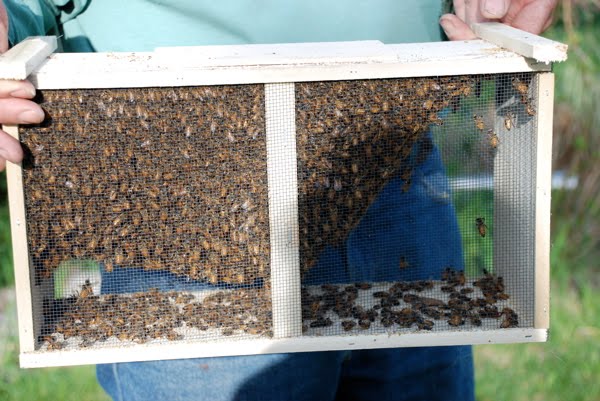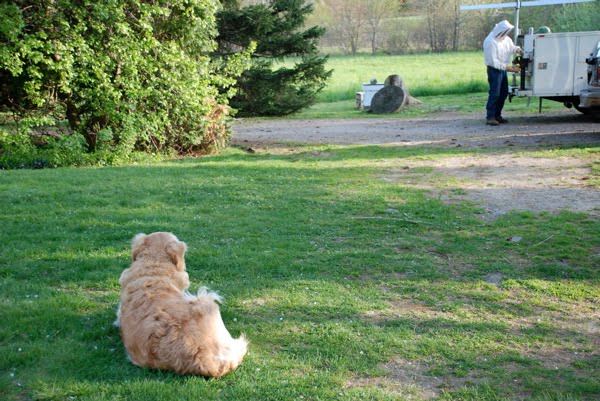Two weeks ago, JR and I schlepped down the formerly-closed-by-flood-waters Rhode Island leg of Route 95 to our beeman’s house in Warwick, RI. Not just a beekeeper, this particular beeman is also the supplier of new bee colonies to quite a number of beekeepers in the Northeast.
Over the course of two winters, we had lost all three of our hives, not to the mysterious colony collapse disorder, as you might suspect, but instead, from a presumed freezing.
Unlike in colony collapse disorder, in which the beekeeper finds an empty hive, our hives were full. Full of dead bees. Thousands of them, in fact. With both JR and I raised in the Judeo-Christian tradition, we tend to believe that this is our fault. If only we had done more to insulate the hives. If only we had placed all three hives closer together. If only I had knit tiny bee sweaters. After learning to knit, that is.
The beeman lives at the end of a dead-end road in what appears to be a World War II era veterans’ housing plat of small ranch homes, yet the beeman’s house is in the woods, the only dwelling on the street with a non-manicured lawn. Beekeepers drive up to the garage, a pale blue vinyl sided affair situated in front of a similarly sided two-story house. They then park, enter the garage, and select from a what appears to be a small city of shoebox-sized containers, each one holding a bee colony. There are hundreds of these boxes, stacked floor to ceiling, the whole garage deep, the whole garage wide. One wooden-framed box with ten thousand bees clinging together inside constitutes one beehive.
I sat in the car while JR entered the garage to fetch our three bee packages. A pick-up truck pulled in behind our parked car, the New Jersey plate shocking me out of my bleary-eyed, not-quite-enough-coffee-yet 9am state. Bee dealers are apparently a bit scarce, as this New Jersey beekeeper had made the commitment to get up sometime around 4am on a Saturday to collect his bees in Rhode Island. I made a note to myself: stop complaining about the half-hour drive to the beeman’s, okay? And this after the bees are driven north from Georgia in a tractor-trailer; so much travel for these wee pollinators.
While the New Jersey beekeeper and I waited outside, inside the garage, the beeman and JR discussed this freezing problem we have. “Not much you can do,” said the beeman, “once they get out of the cluster, that next freeze is going to be a problem.”
During the winter, the hives are wrapped with insulation – could be tar paper, could be house wrap, or could even be those sheets of pink insulation. The bees remain inside for the winter, clustered in a huge ball for warmth. As is so frequently the case in New England, we’ll get a warm day in February or March. The bees start flying – such a promising sight to see in the middle of the winter doldrums – removing their dead and depositing them outside the hive (a cleaning process that goes on throughout the warm weather as well), and then, that night, the temperature drops down to -4 with the windchill (oh, how we despise that saying here, “with the windchill”), and the bees are unprepared. They aren’t all gathered together, and so there is no warmth. And just like that, the bees are dead. It’s incredibly disappointing on the next late-winter warm day when no bees fly, and you know that they didn’t make it.
“He doesn’t even wrap his hives,” JR reported. “No?” “No. He said it’s all about ventilation. Cripers, he even props the cover open.” The hives we have are, as JR said, “all about ventilation.” We bought them from a beeman in Canada who designed the hives himself, with extra ventilation. You might imagine, a Canadian beekeeper has the same issues of frozen bees that we in Massachusetts have. “He even keeps some of his bees in tree trunks,” JR said, as he turned the key in the ignition. We circled left in the roundabout, and sure enough, directly in front of us was a Pooh Bear-style tree trunk, hollowed out in an arch at the bottom, set upon a regular beehive base, bees darting in and out of it.
“That’s got to be quite the honey extraction process,” I said. JR then informed me that the beeman puts what are called honey supers (the portion of the man-made beehives that are specifically for the honeycomb, not for brood – brood being a fancy name for larvae) atop the tree section as the summer progresses so that his honey extraction process is no different than any other human-built beehive user’s.
The last time we purchased bees, I did the pick-up run solo. There had been some miscommunication between the beeman and JR – about a week’s delay from when they arrived from Georgia to when I collected them – and by the time I showed up outside the garage, there were but a handful of bee packages left. Those that were were weakened, thousands of bees lying dead on the bottom of each box. We installed them quickly, and two of the hives made it through the following winter, but with such a rough start, they never really flourished.
This time would be different. Not only did we arrive the morning after the “bees are in” phone call (that’s literally all that the beeman says), we also installed them quickly. And by “we”, I definitely mean “JR”. And by “quickly”, I mean, “that afternoon.” I did stand by with my camera to document the event, and was dive-bombed a couple of times, but the real work of it was left to my beeman, JR, all suited up and ready for hiving our not-so-Pooh-Bear hives.
I know everyone thinks their dog is the smartest, but really, now, look at her. She knows to keep a safe distance from the hiving activity. Don’t even go to the “ah, yeah, well, I’ll bet dogs know instinctively that buzzing bees equal bad” place. We like to think she’s just wicked freaking smart (And, yes, my Massachusettsness is coming out in full force in that last sentence, thank you very much.)
In the interest of brevity (she says, the irony completely lost on her), I’ll post the succession of photos of JR actually installing the hives tomorrow. Pretty amazing stuff, this beekeeping is.



“With both JR and I raised in the Judeo-Christian tradition, we tend to believe that this is our fault.”
Classically awesome. Looking forward to the next beekeeping installment!
Kate